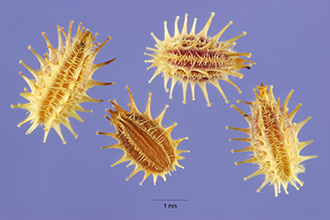American Wild Carrot
Scientific Name: Daucus pusillus Michx.

| General Information | |
|---|---|
| Usda Symbol | DAPU3 |
| Group | Dicot |
| Life Cycle | Annual |
| Growth Habits | Forb/herb |
| Native Locations | DAPU3 |
Plant Guide
Alternate Names
Rattlesnakeweed, southwestern carrot, seedticks,rattlesnake-weed, yerba del vibora
Uses
Ethnobotanic: Native Americans ate the roots raw andcooked (Epple 1995). Medicinal: In California this species is calledrattlesnake weed, because the herbage is reputed to beefficacious in the treatment of snake bites (Moldenke1949). A poultice of the chewed plant has beenapplied to snakebites (Moerman 1998). A decoctionhas been used to treat colds, itches and fevers (Ibid.).
Status
Please consult the PLANTS Web site and your StateDepartment of Natural Resources for this plant’scurrent status (e.g. threatened or endangered species,state noxious status, and wetland indicator values).
Description
General: Celery Family (Apiaceae). Daucus pusillusis a native annual found most commonly during theearly-mid part of the growing season. In most parts ofTexas, this species has gone to seed by mid-summer. Rattlesnake-weed resemble their cultivated relative,the garden carrot. The stem is normally slender, from 2-4 feet in height and unbranched or only a singleweak branch as compared to the introduced Daucuscarota, which is sometimes heavily branched and morerobust. The flower is a white umbel. Upon maturity,the flower cluster (umbel) closes to form a cup orbird’s nest. The leaves are pinnately compound andfinely cut. Leaflets are deeply serrated (saw-toothed). The seed of Daucus carota have fine hairs rather thanthe stiff bristles common to Daucus pusillus. Anotherdistinguishing characteristic between the two species isthe central flower of each individual umbellet is roseor purple in Daucus carota rather than being whitethroughout as found in Daucus pusillus. American wild carrot is self-fertile. The flowers arehermaphrodite, having both male and female organs,and are pollinated by flies and bees. A similar species is water parsnip (Sium suave), whichhas a corrugated main stem and leaves only oncecompound. Bishop’s weed (Ammi majus) and waterhemlock (Cicuta maculata) have white umbels, but theleaflets are not deeply serrated or carrot like.
Distribution
Daucus (pusillus or carota) is likely the most commonand widespread plant with white umbels growingalong Texas’ roadsides. It is known from the U.S. West Coast and the southern half of the U.S. Forcurrent distribution, please consult the Plant Profilepage for this species on the PLANTS Web site.
Establishment
Adaptation: It is very common along road right-of-ways. It can also become quite dominant in somepastures and prairies. Rattlesnake-weed prefers moist,loamy sites, but not wet sites. The exotic, Daucuscarota, tolerates a much broader site in Texas, rangingfrom blackland to rock outcrops. American wild carrot requires moist, well-drained soiland prefers sandy, loamy and clay soils. It grows bestin a sunny position and cannot tolerate shade. Thisspecies occurs in rocky prairies, openings in woodland,and rocky open, frequently limestone, glades, andedges of bluff escarpments, sometimes along roadsidesand railroads (Steyermark 1963). Propagation by Seed: American wild carrot seeds arebest sown in the autumn. Always aim to sow thinlyand evenly to permit adequate room for the seedlingsto grow and develop freely (Heuser 1997). The seedswill germinate better if they are cold stratified. Cultivars, Improved and Selected Materials (andarea of origin) © Lee DavisUSDA, NRCS, Nacogdoches Technical Office These plant materials are readily available fromcommercial sources.
References
Abrams, L, 1944, Illustrated flora of the PacificStates:Washington, Oregon and California, Vol III, Stanford University Press, Stanford, California, Davis, L, 2000, Texas plant fact sheet: Daucuspusillus, USDA, NRCS, Nacogdoches TechnicalOffice #2, Nacogdoches, Texas, Epple, A,O, 1995, A field guide to the plants ofArizona, Falcon Press, Helena, Montana, Heuser, C,W, 1997, The complete book of plantpropagation, The Taunton Press, Newtown,Connecticut, Moerman, D, 1998, Native American ethnobotany, Timber Press, Portland, Oregon, Moldenke, H,N, 1949, American wildflowers, D, VanNostrand Company, Inc,, New York, New York, Muenscher, W,C, 1955, Weeds, 2nd ed, CornellUniversity Press, Ithaca, New York, Munz, P,A, & Keck, D,D, 1965, A California flora, University of California Press, Los Angeles,California, Radford, A,E, Use soil moisture sensors to measure the soil moisture of American Wild Carrot.,, H,E, Ahles, & C, Bell 1968, Manual ofthe vascular flora of the Carolinas, The University ofNorth Carolina Press, Chapel Hill, North Carolina, Steyermark, J,A, 1963, Flora of Missouri, The IowaState University Press, Ames, Iowa, USDA, NRCS 2000, The PLANTS database, <http://plants,usda,gov>, 001206, National Plant DataCenter, Baton Rouge, Louisiana,
